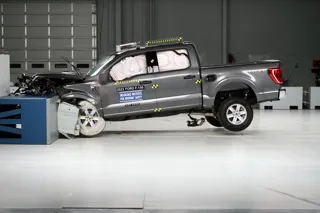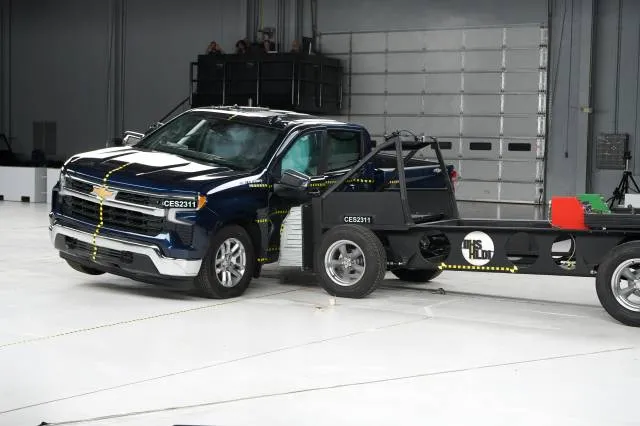Pickup trucks fail to protect rear-seat passengers

Full-size pickup trucks earned mixed results in two updated crash tests performed by the Insurance Institute of Highway Safety, the nonprofit safety agency announced Tuesday.
Crew cab versions of the Ram 1500, Ford F-150, and Toyota Tundra earned top “Good” ratings in the updated side impact test, while the Chevy Silverado 1500 earned an “Acceptable” rating.
In the updated moderate-overlap front crash test that measures rear passenger safety, however, the Ram 1500, Ford F-150, and Toyota Tundra earned “Poor” ratings. The Tundra earned a “Marginal” rating.
The update to the moderate-overlap front crash test was introduced last year to extend passenger protection to rear occupants. It was the IIHS’ oldest test, first launched in 1995, and the updates were intended to measure rear-passenger safety. The new test uses a dummy sized like a small woman or 12-year-old child positioned in the seat behind the driver, where protection has lagged recently.
“Like most other vehicle classes, large pickups don’t perform as well in the new moderate overlap evaluation as they do in the updated side test,” IIHS President David Harkey said in a statement.
Most crossover SUVs tested recently by the IIHS fared similarly, as did minivans, small cars, and other segments. The IIHS updates tests to reflect changes to modern roadways, such as larger vehicle sizes traveling at higher speeds. The tougher side-impact test changed from a strike barrier weighing 3,300 pounds, as it had been since 2003, to a 4,180-pound barrier in 2023. The average weight of an SUV has increased 1,000 pounds to 4,600 pounds, according to the IIHS.
IIHS pickup truck safety test

IIHS pickup truck safety test

IIHS pickup truck safety test
Historically, rear-seat occupants were cushioned from front crashes by the front seats and the front crumple zone. Since model year 2007 onward, however, the IIHS found that fatal injury is 46% higher for belted occupants in the rear seat than those in the front seat.
The rear seat hasn’t become any more unsafe, but safety advances to front seat occupants have grown due to airbags, restraint technologies, and other areas of focus that the IIHS wants to see applied to the rear seats.
In recent years, car cabins have incorporated more rigid crumple zones so there is less deformation from a front crash in the passenger cabin.
The updated test was introduced last year and first applied to the most popular vehicle segment of compact crossovers. Most small crossovers—nine out of 15 tested—failed to protect rear passengers.
The front-overlap test remains the same, but the additional dummy gets tested for excessive risk of injury to the head, neck, chest, abdomen, or thigh. For a vehicle to earn a “Good” rating, there can’t be excessive risk of injury to those areas.
Chest injuries were a particular focus since they are the most common serious injury in the rear seat for adults. It also tests to see if the body “submarines” beneath the lap belt.
“Submarining was a problem for all four pickups, and belt forces were too high in all but the Tundra,” Harkey said.
The IIHS said the rear seat of crew cabs is still the safest place for children, who can be injured by a front airbag inflating in the front passenger seat.
https://www.thecarconnection.com/news/1141358_iihs-pickup-trucks-fail-to-protect-rear-seat-passengers Pickup trucks fail to protect rear-seat passengers



